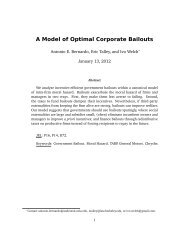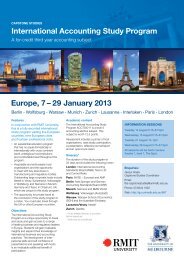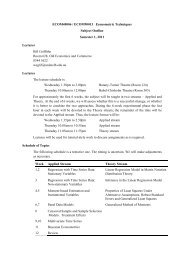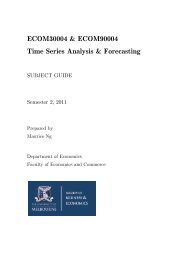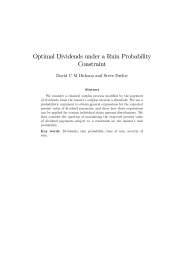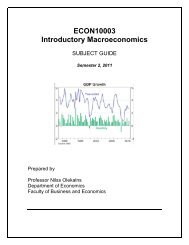Bayesian Inference in the Seemingly Unrelated Regressions Model
Bayesian Inference in the Seemingly Unrelated Regressions Model
Bayesian Inference in the Seemingly Unrelated Regressions Model
Create successful ePaper yourself
Turn your PDF publications into a flip-book with our unique Google optimized e-Paper software.
9<br />
where<br />
 is an ( M × M ) matrix with ( i, j)<br />
-th element given by<br />
[ Aˆ<br />
] = ( y − X βˆ<br />
)( ′ y − X βˆ<br />
)<br />
ij i i i j j j<br />
The posterior pdf <strong>in</strong> (21) is not an analytically tractable one whose moments are<br />
known. However, as we will see, we can draw observations from it us<strong>in</strong>g <strong>the</strong> Gibb’s<br />
sampler.<br />
III.<br />
ESTIMATING POSTERIOR QUANTITIES<br />
Given <strong>the</strong> <strong>in</strong>tractability of <strong>the</strong> posterior pdf<br />
2<br />
f( β| y)<br />
∝ A −T<br />
, methods for estimat<strong>in</strong>g<br />
marg<strong>in</strong>al posterior pdf’s for <strong>in</strong>dividual coefficients β ik , <strong>the</strong>ir moments, and<br />
probabilities of <strong>in</strong>terest, are required. Suppose that we have draws<br />
(1) (2) ( N )<br />
β , β ,...., β<br />
taken from f( β | y)<br />
and, possibly, draws<br />
(1) (2) ( N )<br />
Σ , Σ ,..., Σ taken from f( Σ | y)<br />
. We<br />
will describe a number of ways one can proceed to estimate <strong>the</strong> desired quantities;<br />
<strong>the</strong>n, we discuss how <strong>the</strong> required posterior draws can be obta<strong>in</strong>ed.<br />
A. Estimat<strong>in</strong>g Posterior pdf’s<br />
A simple way to estimate <strong>the</strong> marg<strong>in</strong>al posterior pdf of β ik<br />
, say, is to construct a<br />
histogram of draws of that parameter. Jo<strong>in</strong><strong>in</strong>g <strong>the</strong> mid po<strong>in</strong>ts of <strong>the</strong> histogram classes<br />
provides a cont<strong>in</strong>uous representation of <strong>the</strong> pdf, but, typically, it will be a jagged one<br />
unless some k<strong>in</strong>d of smooth<strong>in</strong>g procedure is employed. Alternatively, one can obta<strong>in</strong><br />
a smooth pdf, and a more efficient estimate, by averag<strong>in</strong>g conditional posterior pdf’s<br />
for <strong>the</strong> quantity of <strong>in</strong>terest. In this case, for conditional posterior pdf’s one can use <strong>the</strong><br />
t-distributions def<strong>in</strong>ed by (19), or, if draws on both<br />
distributions def<strong>in</strong>ed by (14).<br />
β and<br />
Σ are available, <strong>the</strong> normal<br />
Consider<strong>in</strong>g <strong>the</strong> t-distribution first, an estimate of f( β | y)<br />
is given by<br />
ik



